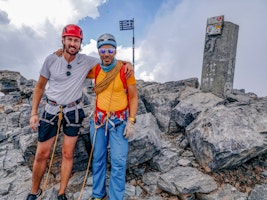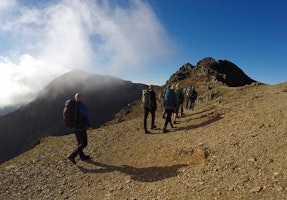Many people use the words “hiking” and “mountaineering” as if they were synonyms. However, and even if they both refer to outdoor activities in the mountains, there are some important differences that you should be aware of, especially if you are planning a trip yourself.
 differences between hiking and mountaineering
differences between hiking and mountaineering
According to Wikipedia, hiking refers to a “long vigorous walk, generally on trails (footpaths)”. It may also be referred to as hillwalking in the UK, tramping in New Zealand or bush walking in Australia. Mountaineering, on the other hand, is defined as “the sport of climbing mountains” and may also be referred to as “alpinism” (especially in Europe). It generally involves a greater technical difficulty and requires specialized equipment (including harness, helmet, belay device, crampons, etc.).
But let’s take a better look at what these activities involve. For practical purposes, we’ll refer to 3 basic differentiating features between these 2 terms:
Technical Difficulty
Equipment required
Type of terrain
What is Hiking About?
There are hikes of varying levels of difficulty and duration. A hiking trip can take anywhere from a few hours to several days and, as a rule, no technical knowledge is necessary. Some basic navigation techniques and a good fitness level will be more than enough to take you from start to finish.
In general, hiking can be practiced year-round except for areas where snow abounds during winter, in which case snowshoes are an option.
 differences between hiking and mountaineering
differences between hiking and mountaineering
While we are at it, let’s also examine the differences between “hiking” and “trekking”. Although many people use these terms interchangeably, others use “trekking” to refer to walks that take place on wilder and often more difficult trails. In general, trails are also characterized by being longer and in more remote locations.
“Scrambling” is another related term that may need some explaining. This is a somewhat ambiguous term as it refers to a combination of walking on a mountain and sport climbing. It consists of the action of climbing mountains or rock walls without the use of technical equipment or ropes. Sometimes it is also called "rock scrambling" or "alpine scrambling". The main difference with hiking is that you need to use your hands during the ascent.
 differences between hiking and mountaineering
differences between hiking and mountaineering
Going back to “hiking”, those with some experience can probably handle some easy trails on their own. However, it is always advisable to do it together with a certified mountain leader or guide as they can provide a richer experience by teaching you about local weather, culture and history. The UIMLA (Union of International Mountain Leader Associations) is an umbrella association for mountain leaders in 16 countries.
In need of inspiration? Check out some great hikes promoted on Explore-Share by certified guides and leaders around the world.
In Europe:
Tour du Mont Blanc (TMB);
The great Selvaggio Blu hike in Cerdinia offered by IFMGA guide Stéphane.
 Differences between hiking and mountaineering
Differences between hiking and mountaineering
In Asia:
Hiking in the Daisetsuzan Park, Hokkaido, along with JMGA guide Jun;
South America:
Hut-to-hut hiking programs in Bariloche;
Hiking traverses in El Chaltén, the Argentine trekking capital;
Amazing hikes in Torres del Paine, Chile, led by UIMLA mountain leader José.And if you've always dreamed with a hiking trip to Iceland, check out our top 5 hiking spots in the country!
What is Mountaineering About?
Although mountaineering trips also range from a few hours to several days, this activity is in general more physically and technically demanding than hiking or trekking. On the way to the summit, mountaineers will have to deal with rock, ice or mixed terrain.
 differences between hiking and mountaineerin
differences between hiking and mountaineerin
Altitude is another added challenge. When attempting an ascent over 4,000 meters, good acclimatization is one of the key factors to achieve success. Depending on the mountain, climbers may need to know how to walk on crampons or how to use an ice axe and ice climbing or rock climbing skills may also be necessary to get to the top.
Although there are winter programs, mountaineering trips usually run during spring, summer and mid-autumn, when the presence of snow and winds decrease. Hiring the services of a certified mountain guide is not only crucial to improve the group’s chances of reaching the summit but, more importantly, it is key to keeping the group safe.
It is therefore essential to hire guides certified by IFMGA (International Federation of Mountain Guides Associations) or by national associations recognized by IFMGA. Looking for some new summit goals? Here are some mountaineering trips proposed by certified professionals via Explore-share.com:
Matterhorn mountaineering expedition led by IFMGA guide Guy;
Mont Blanc 7 day climb guided by IFMGA-certified Francis;
Climbing Aconcagua, the highest summit in South America, along with Julver, an IFMGA guide from Peru.
Climbing Mount Elbrus, the highest mountain in Europe, with IFMGA-certified Ivan.
 Differences between hiking and mountaineering
Differences between hiking and mountaineering
Finally, for those who want to give mountaineering a try but don’t have too much experience, we recommend this interesting article about the 5 easiest summits in the Alps for beginners.
Mountaineering Equipment
Unlike hiking, mountaineering requires the use of technical equipment. Participants may need to be able to use the following gear:
Rope,
Harness,
Helmet,
Ice axe(s),
Crampons,
Belay device,
Carabiners,
Ice screw.
In many cases, mountain guides will be able to provide the technical equipment. In others, mountaineers may be able to rent the equipment before the start of the trip. Always make sure you validate the equipment list with your guide!
To Sum Up…
Technical level, equipment and terrain are key to determine whether an outing can be classified as hiking or mountaineering. While hiking programs are suitable for almost anyone with a good fitness level and a small backpack, mountaineering requires some degree of rock and ice climbing techniques and the use of specialized equipment.
Be aware, however, that grey areas exist, so make sure to ask your mountain guide all the relevant question beforehand in order to make sure you are ready for the trip — both technically and physically. If you’re more of a hiker, you may want to ask, for example, if an ascent requires any technical skills (like the use of crampons to walk on a glacier) or if your fitness level is appropriate.
 Differences between hiking and mountaineering
Differences between hiking and mountaineering
While experienced hikers may be able to handle short easy hikes on their own, it is always advisable to hire a guide for longer or more difficult treks. A mountain guide’s knowledge and expertise will provide an added value to the experience and will be key to handle logistics (so you’ll have more time to just enjoy the adventure!). Mountaineering generally involves some added risks — including changing weather conditions and altitude — so we recommend always hiring the services of a certified guide.
 differences between hiking and mountaineering
differences between hiking and mountaineering
We hope you are now ready to safely enjoy your adventure. Don’t hesitate to check out Explore-Share.com’s selection of hiking and mountaineering trips!







